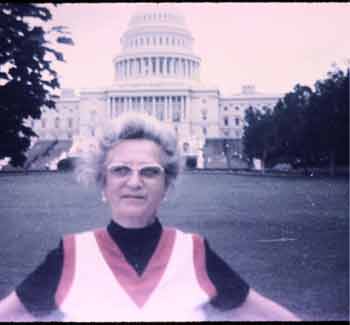T]he discourse of mimicry is constructed around an ambivalence; in order to be effective, mimicry must continually produce its slippage, its excess, its difference.
–Homi Bhabha
excess: n 1. the state of exceeding what is normal or sufficient. 2. An amount or quantity beyond what is normal or sufficient; a surplus. 3. The amount or degree by which one quantity exceeds another. 4 Intemperance; overindulgence. 5. A behavior or an action that exceeds proper or lawful bounds.
–American Heritage Dictionary

I came to family images, family pictures as I completed my book, Jews and Feminism: The Ambivalent Search for Home. 1 At that time, I found myself using this snapshot of my grandmother to describe my own ambivalent embrace of the promises of American citizenship. I used this picture to illustrate my family’s often exaggerated claims to American culture and the State. I felt that, in its excess, this photograph also said something about our insecurity and fears that we were not quite American enough. Because I saw all of these desires expressed in my grandmother’s patriotism, her literal, albeit fragile, embrace of the Dome of the Capital in Washington, D.C., I used this photograph as the frontispiece in my book.
Now as I return to this image years later, I want to shift my focus. Here I want to think some more about how this same image has been framed and reframed, not only by me, but by some of the other places where this image resides. In order to do this I return to the home where I grew up in Dover, Delaware, the two story colonial my parents bought in 1966, as we left Long Island, and where my parents have lived ever since. In this place, this photograph not only continues to speak to that same exaggerated set of desires to claim America that I write about in my book, it is also a part of another narrative. As I will demonstrate, the placement of this image of my grandmother on a particular wall within a specific room in this house situates this photograph in a different kind of excessive economy of family pictures. It is this more peculiar, more intimate and indeed more idiosyncratic legacy and its Jewishness that I want to explore in this brief essay.
At stake in this essay is how the visual legacy I grew up with was both Jewish and gendered. I want to address how our family pictures, including this photograph of my grandmother, are part of a larger visual field which includes my father’s and brother’s paintings and drawings. I am interested in what story these pictures tell in the narrative of our Jewishness.
I began these reflections as part of my presentation at the Rennert Women in Judaism Forum at Barnard. 2 At that time, I puzzled over these other family pictures, my father’s and my brother’s paintings and drawings, and came to few tentative conclusions. I knew that my father and my brother shared a gendered legacy of picture-making in our family but saw only this masculine enactment. What troubled me then were not so much the similarities between their pictures but the different roles their works played in the intimate economy of our family. I took for granted the sheer excess of my father’s images and their display.
It was not until Irena Klepfisz and Susan Shapiro, friends and colleagues who attended the forum, came up to me after my presentation and expressed how strange and creepy they found the walls of my family’s home, covered with my father’s images, that I was able to begin to unravel some of my own habits of seeing enough to notice other things. 3
- Laura Levitt, Jews and Feminism: The Ambivalent Search for Home (New York: Routledge, 1997).[↑]
- “Changing Focus: Family Photograph and Jewish American Identity,” panel discussion, The Rennert Women in Judaism Forum, Barnard College, New York, New York, January 31, 2001.[↑]
- I thank Irena Klepfisz and Susan Shapiro for sharing their responses with me at Barnard. Here as in many other ways their insights remain crucial to my thinking.[↑]


